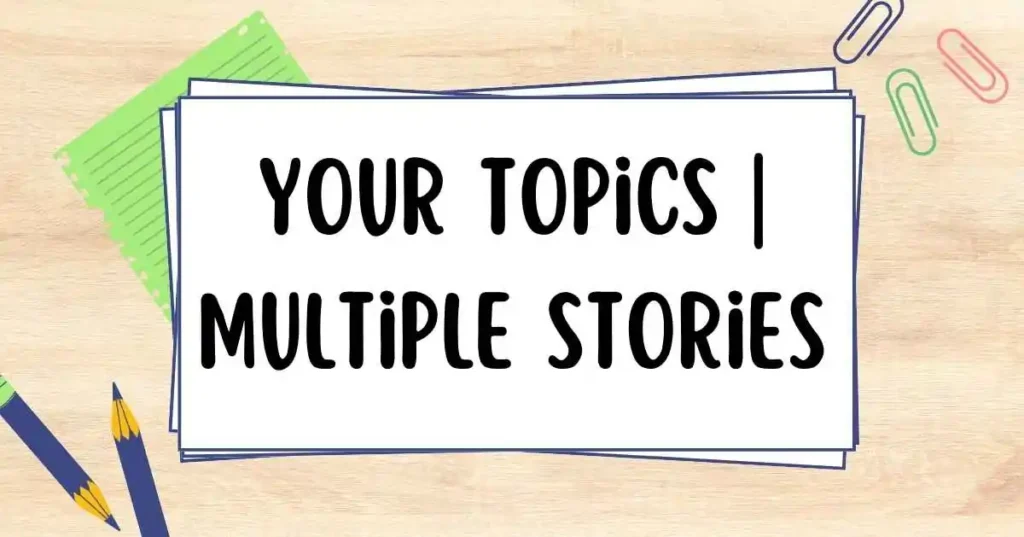Introduction
In a world filled with endless perspectives, every individual carries a unique story. Whether it’s personal experiences, fictional tales, or historical accounts, narratives shape our understanding of life. The phrase “your topics | multiple stories” highlights the beauty of diverse storytelling—where different voices, themes, and genres come together to create a rich tapestry of human expression.
This article delves into the significance of multiple stories, examining how varied topics can captivate audiences, foster empathy, and broaden our worldview. From personal anecdotes to fictional universes, we will explore why embracing diverse narratives is essential in today’s interconnected society.
The Power of Multiple Stories
Stories have always been a fundamental part of human culture. They entertain, educate, and inspire. When we engage with multiple stories, we open ourselves to different realities, perspectives, and emotions. Here’s why they matter:
1. Expanding Perspectives
Every story offers a new lens through which we can view the world. Whether it’s a memoir from someone with a completely different background or a fantasy novel set in an alternate universe, diverse narratives challenge our assumptions and broaden our thinking.
2. Fostering Empathy
Reading or listening to someone else’s story helps us understand their struggles, joys, and experiences. This builds empathy, making us more compassionate and connected as a society.
3. Encouraging Creativity
Exposure to different storytelling styles—whether through books, films, or oral traditions—fuels our own creativity. Writers, artists, and creators often draw inspiration from a mix of sources to craft something original.

Exploring Different Types of Stories
Under the umbrella of “your topics | multiple stories,” we can categorize narratives into several types:
1. Personal Stories
These are real-life accounts shared by individuals—autobiographies, personal essays, or even social media posts. They offer raw, unfiltered glimpses into people’s lives.
- Example: A refugee’s journey to a new country.
- Why It Matters: These stories humanize abstract issues, making them relatable.
2. Fictional Stories
From classic novels to modern sci-fi, fiction allows us to escape reality while still reflecting on real-world themes.
- Example: A dystopian novel exploring societal control.
- Why It Matters: Fiction can critique real-life issues in a way that’s engaging and thought-provoking.
3. Historical Narratives
These stories document past events, preserving cultural heritage and teaching future generations.
- Example: The retelling of a major historical battle from multiple viewpoints.
- Why It Matters: They prevent history from being forgotten and offer lessons for the present.
4. Mythological & Folklore Tales
Every culture has its myths and legends, often passed down through generations.
- Example: Greek mythology or African folktales.
- Why It Matters: They preserve cultural identity and teach moral lessons.
The Role of Multiple Stories in Media
Modern media thrives on multiple stories. Streaming platforms, podcasts, and bookshelves are filled with a variety of genres and voices. Here’s how different media formats embrace this diversity:
1. Books & Literature
Publishers now prioritize diverse authors, ensuring that underrepresented voices are heard. From memoirs to fantasy, readers have access to an expansive range of topics.
2. Film & Television
Movies and TV shows now feature more inclusive storytelling, representing different cultures, genders, and experiences.
3. Podcasts & Digital Storytelling
The rise of podcasts has allowed for niche stories to reach global audiences, from true crime to personal development.
How to Engage with Multiple Stories
If you want to explore your topics | multiple stories, here are some ways to dive in:
- Read Widely – Pick books outside your usual genre.
- Listen to Diverse Voices – Follow podcasts or YouTube channels that share unique perspectives.
- Discuss & Share – Join book clubs or online forums to exchange thoughts.
- Create Your Own Stories – Whether through writing, vlogging, or art, contribute your narrative to the world.
Frequently Asked Questions (FAQs)
1. Why is it important to explore multiple stories?
Engaging with diverse narratives helps broaden perspectives, fosters empathy, and encourages critical thinking. It allows us to understand different cultures, experiences, and worldviews beyond our own.
2. How can I find stories outside my usual interests?
Try exploring book recommendation lists, joining online reading communities, or asking friends for suggestions. Platforms like Goodreads, StoryGraph, or even library displays can introduce you to new genres.
3. Can fictional stories have real-world impact?
Absolutely! Fiction often reflects societal issues, challenges norms, and inspires change. Books like 1984 or To Kill a Mockingbird have shaped public discourse on politics and equality.
4. What’s the best way to share my own story?
You can start a blog, contribute to online platforms like Medium, or even share on social media. If you prefer storytelling through audio, consider starting a podcast or joining open-mic events.
5. How do multiple stories improve creativity?
Exposure to different narratives introduces new ideas, writing styles, and perspectives. This cross-pollination of thoughts helps creators develop unique and innovative content.
Conclusion
The phrase “your topics | multiple stories” reminds us that storytelling is not monolithic—it’s a vast, ever-evolving landscape of voices and experiences. By embracing diverse narratives, we enrich our minds, deepen our empathy, and connect with others on a profound level.
Whether you’re a reader, writer, or simply a listener, there’s always a new story waiting to be discovered. So, explore widely, share generously, and remember—every story matters.



